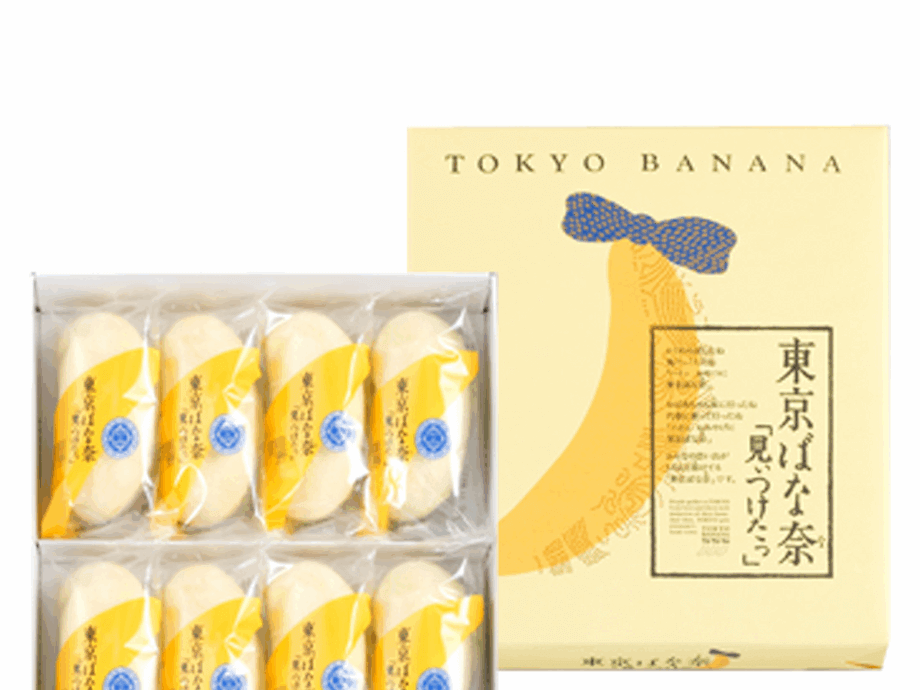The Rise of Tokyo Banana: From Marketing Gimmick to Cultural Icon
Walk through any major train station or airport in Tokyo, and you’ll be greeted by stacks of pale-yellow boxes adorned with playful banana motifs and images of the city’s landmarks. These are Tokyo Banana, the city’s most famous souvenir snack, and their story is as unique as their taste. Despite Tokyo’s lack of banana trees, these banana-shaped sponge cakes have become a symbol of the metropolis, beloved by tourists and recognized across Japan and beyond.
- The Rise of Tokyo Banana: From Marketing Gimmick to Cultural Icon
- What Is Tokyo Banana?
- Omiyage: The Japanese Tradition of Edible Souvenirs
- The Birth of a Modern Souvenir
- Marketing Genius: Why Tokyo Banana Became a Must-Buy
- Flavor Innovations and Limited Editions
- How Tokyo Banana Compares to Other Japanese Souvenir Sweets
- Where to Buy Tokyo Banana
- Beyond the Banana: Grapestone’s Expanding Snack Empire
- Is Tokyo Banana Worth the Hype?
- Tokyo Banana’s Place in Japanese Pop Culture
- In Summary
But how did a simple banana-flavored cake, invented just over three decades ago, come to represent the world’s largest city? The answer lies in a blend of clever marketing, cultural tradition, and a keen understanding of what travelers want to take home.
What Is Tokyo Banana?
Tokyo Banana is a soft, fluffy sponge cake shaped like a banana and filled with a creamy banana custard. Each cake is individually wrapped, ensuring freshness for about a week—just long enough for travelers to bring them home as gifts. The original flavor, known as “Miitsuketa!”, uses real banana puree to create its signature taste, and the cakes are both baked and steamed for their distinctive texture.
Since its debut in 1991, Tokyo Banana has expanded its lineup to include a dizzying array of flavors and limited editions: chocolate, caramel, honey, sakura (cherry blossom), lemon, and even collaborations with beloved characters like Pikachu, Hello Kitty, and Doraemon. The brand has also ventured into other treats, from banana cheesecakes and cookies to exclusive milkshakes and even curry bread filled with banana puree.
How Tokyo Banana Is Made
The cakes are produced in a factory in Tokorozawa, Saitama, just outside Tokyo. The process involves baking and steaming the sponge to achieve its signature softness, then injecting it with a smooth banana custard made from real banana puree. The result is a cake that’s light, moist, and distinctly banana-flavored—though some critics say the taste leans toward the artificial side.
Omiyage: The Japanese Tradition of Edible Souvenirs
To understand Tokyo Banana’s success, it’s essential to grasp the Japanese custom of omiyage. Unlike Western souvenirs, which might be trinkets or T-shirts, omiyage are almost always edible gifts brought back for friends, family, and colleagues after a trip. The practice is deeply ingrained in Japanese culture, serving as both a token of appreciation and a kind of apology for leaving others behind.
Omiyage are typically regional specialties—think matcha sweets from Kyoto or apple treats from Aomori. They’re beautifully packaged, individually wrapped, and often perishable, meant to be consumed soon after the traveler’s return. The ritual of choosing the perfect omiyage is nuanced, with expectations around quality, presentation, and even the number of pieces in a box (to ensure everyone gets one).
Tokyo, however, historically lacked a signature edible souvenir. As the city grew into a global metropolis in the late 20th century, it became a melting pot without a single culinary tradition to call its own. This gap presented an opportunity for innovation.
The Birth of a Modern Souvenir
Enter Grapestone Co., a Japanese snack manufacturer that saw the need for a Tokyo-centric omiyage. In the early 1990s, when offered retail space at Haneda Airport, Grapestone set out to create a product that would evoke nostalgia and familiarity for Japanese people from all regions, while also appealing to international visitors.
As a Grapestone representative explained,
“Tokyo is the place where various people come from all over Japan and it becomes a hometown for them. We decided to invent a Tokyo souvenir with the theme which all Japanese people will feel familiar and nostalgic about. Bananas are the taste of high-end products or imported goods for older people. For younger people, it is the taste of fun memories bringing bananas on field trips.”
The result was Tokyo Banana—a snack that, while not rooted in centuries-old tradition, quickly became a modern classic. Its name, packaging, and flavor were all carefully chosen to resonate with both locals and tourists, and its launch at the airport ensured maximum exposure to travelers.
Marketing Genius: Why Tokyo Banana Became a Must-Buy
Tokyo Banana’s meteoric rise is a case study in branding and marketing. By using the city’s name and English-language packaging, Grapestone positioned the snack as the definitive Tokyo souvenir. The cakes are sold in eye-catching yellow boxes, often tied with gold ribbons and decorated with images of Tokyo’s skyline or popular cartoon characters.
Jeff Lui, a Canadian living in Japan, observes,
“You’re almost obligated to buy this omiyage for your friends back home. It’s kind of saying, ‘Hey, I was thinking of you right while I was there, and here’s this thing that I know you will use.’”
Social media has only amplified the craze. TikTokers and Instagrammers flock to Tokyo Banana shops to showcase rare flavors and limited-edition designs, fueling demand among international tourists. Some reviewers compare the cake to a “fancy Twinkie,” noting its playful squishiness and photogenic appeal.
Despite its popularity, not everyone is a fan. Tokyo-based tour guide Katie Thompson admits,
“I’m not the biggest fan. I find the inside to be quite artificial tasting. Banana doesn’t lend itself very well into becoming a sweet custard or candy.”
Still, even those who don’t love the taste acknowledge its status as a must-buy souvenir.
Flavor Innovations and Limited Editions
One of Tokyo Banana’s secrets to staying relevant is its constant innovation. Over the years, the brand has released more than 20 different flavors and countless limited editions. Some are only available at specific locations or during certain seasons, creating a sense of urgency and exclusivity.
Recent hits include:
- Legendary Melon Bread: A special edition melon bread with banana custard, available only at select locations and in limited quantities.
- Tokyo Banana Milkshake: A rich, creamy drink made with banana custard and banana puree, sold exclusively at the Tokyo Station flagship store.
- Collaborations: Cakes featuring Pikachu, Eevee, Hello Kitty, and Doraemon, each with unique designs and flavors.
- Tokyo Banana-flavored Kit Kat: A crossover with Nestlé’s iconic chocolate wafer bar.
These innovations keep the brand fresh and encourage repeat purchases, as fans seek out new and rare varieties.
How Tokyo Banana Compares to Other Japanese Souvenir Sweets
Japan is famous for its regional snacks, each tied to a specific place and often made with local ingredients. Some of the most popular include:
- Shiroi Koibito (Hokkaido): White chocolate sandwiched between crisp cookies.
- Chiba Peanut Monaka (Chiba): Peanut-shaped wafers filled with sweet bean paste and peanuts.
- Kuidaore Taro Pudding (Osaka): Creamy pudding inspired by the city’s food-loving mascot.
- Hiyoko (Fukuoka/Tokyo): Bird-shaped cakes with sweet bean paste.
What sets Tokyo Banana apart is its deliberate creation as a city symbol, rather than a product of local agriculture or centuries-old tradition. Its appeal lies in its accessibility, playful design, and the sense of “Tokyo-ness” it conveys—making it the go-to choice for visitors who want to bring home a taste of the capital.
Where to Buy Tokyo Banana
Tokyo Banana is widely available at airports, train stations, department store basements (depachika), and souvenir shops throughout Tokyo. The flagship store at Tokyo Station offers exclusive items and limited-edition flavors, while pop-up shops and collaborations can be found at major events and tourist hotspots.
Boxes come in various sizes, typically containing four, eight, twelve, or sixteen cakes. Prices are reasonable, and duty-free options are available at airports for international travelers. The cakes are also now sold online, though shipping restrictions and the short shelf life (about seven days) mean they’re still best enjoyed fresh from Japan.
Dietary Considerations and Inclusivity
For Muslim travelers and those with dietary restrictions, it’s important to check ingredient lists and allergen information. While Tokyo Banana is not certified halal, some of its products may be suitable for those avoiding alcohol or non-permissible ingredients. Guides for Muslim-friendly souvenirs in Tokyo often mention Tokyo Banana as a possible option, but always verify before purchasing.
Beyond the Banana: Grapestone’s Expanding Snack Empire
Grapestone, the company behind Tokyo Banana, has leveraged its success to launch other popular snacks. Notably, the Sugar Butter Tree cookies—cereal-butter sandwich cookies with a creamy filling—have gained a cult following and are now available in international markets like Singapore. The company also produces the Ginza Strawberry Cake and collaborates with other brands for unique treats, such as powder-free potato chips with Calbee.
This diversification has helped Grapestone maintain its position at the forefront of Japan’s souvenir snack industry, continually adapting to changing tastes and trends.
Is Tokyo Banana Worth the Hype?
Opinions on Tokyo Banana’s taste are mixed. Some travelers rave about its soft texture and nostalgic banana flavor, while others find it underwhelming or overly sweet. Food critics and bloggers often note that while the cake is “great for gifting,” its flavor is “average” compared to other Japanese sweets.
Yet, the enduring popularity of Tokyo Banana suggests that taste is only part of the equation. The snack’s real power lies in its branding, packaging, and the emotional connection it creates. Bringing home a box of Tokyo Banana is less about the cake itself and more about sharing a piece of Tokyo with loved ones—a gesture that transcends language and culture.
As one reviewer put it,
“Don’t stress about souvenirs; enjoy your trip and use this guide to decide what’s worth buying. Taste is subjective, so try what excites you and form your own opinions.”
Tokyo Banana’s Place in Japanese Pop Culture
Tokyo Banana has become more than just a snack—it’s a pop culture phenomenon. Its collaborations with anime and game characters, appearances in social media challenges, and constant stream of new flavors keep it in the public eye. The brand’s willingness to experiment, from savory curry bread to eco-friendly milkshakes, reflects the broader Japanese approach to food innovation: respect for tradition, but always with an eye on the future.
Even as new competitors emerge and tastes evolve, Tokyo Banana remains a staple of the Japanese omiyage experience. It’s a testament to the power of thoughtful design, clever marketing, and the universal joy of sharing something sweet from your travels.
In Summary
- Tokyo Banana is a banana-shaped sponge cake filled with banana custard, invented in 1991 as a Tokyo-centric souvenir.
- The snack was created by Grapestone Co. to fill a gap in Tokyo’s omiyage (edible souvenir) market and quickly became a symbol of the city.
- Tokyo Banana’s success is rooted in clever branding, constant innovation, and its alignment with Japanese gifting traditions.
- The brand offers a wide range of flavors, limited editions, and collaborations with popular characters, keeping it fresh and exciting.
- While opinions on taste vary, Tokyo Banana’s packaging and emotional appeal make it a must-buy for many travelers.
- Grapestone has expanded its snack empire with other hits like Sugar Butter Tree cookies and unique collaborations.
- Tokyo Banana is widely available in Tokyo’s airports, train stations, and department stores, but has a short shelf life.
- The snack’s enduring popularity highlights the importance of cultural context, presentation, and the joy of sharing food as a souvenir.












